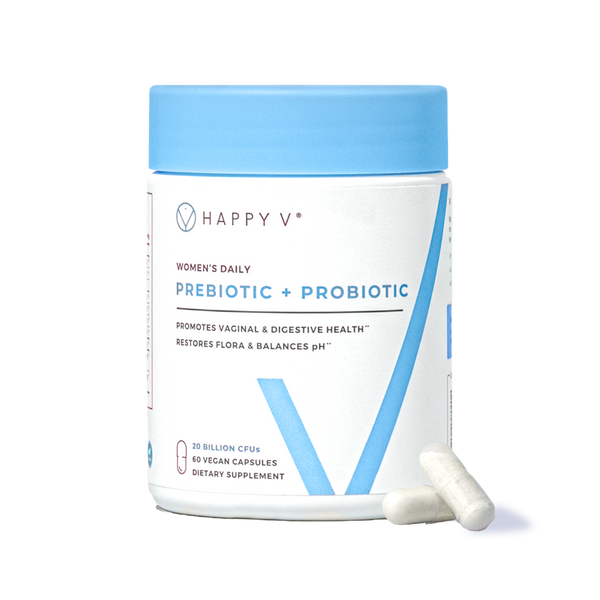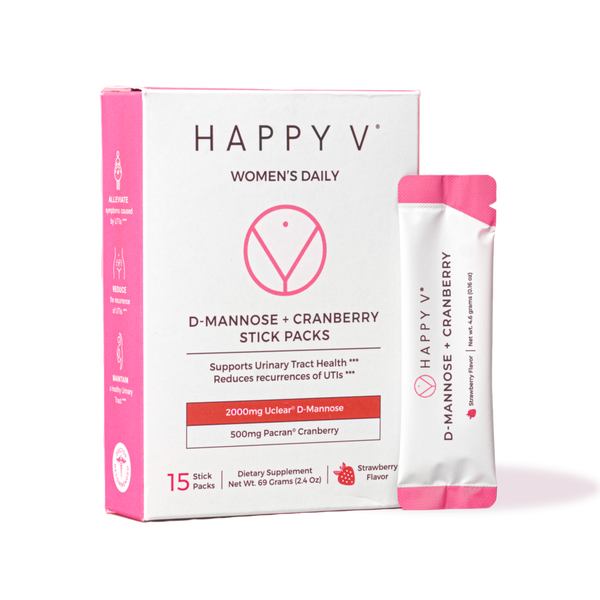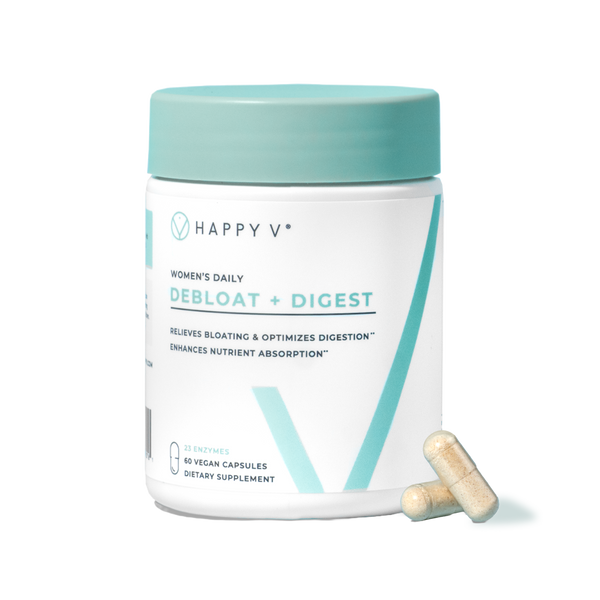- Fact Checked
- July 31, 2025
- 9 min read
Table of Contents
Table of Contents
You may already know that probiotics are a game-changer when it comes to regulating digestion and improving your overall gut health. But did you know that probiotics can actually work that same magic in your vagina and urinary tract?
It’s true! Probiotic supplements may support improve urinary and vaginal health by maintaining the natural balance of beneficial bacteria in those microbiomes1, 2. More beneficial bacteria in the urinary and vaginal microbiome may help maintain microbial balance, which is important for overall wellness.
If you regularly deal with constipation, bloating, or frequent vaginal infections, the question is not “Should I take probiotics?” but “What probiotics should I take?”
Unfortunately, answering this question isn’t always easy. Many businesses and advertisers sell probiotics that make a whole lot of claims but, at the end of the day, don’t do a whole lot to improve women’s health. So how can you spot the good from the bad?
We asked OB/GYN Dr. Barry Peskin for his advice. He’s a healthcare professional with decades of experience, and he gets asked about the benefits of probiotics and how to choose the right probiotic product on a nearly daily basis. Here’s the advice he shares with his patients.
This post is for informational purposes only and does not constitute medical advice. See full disclaimer below.
What Should You Look for in a Women’s Probiotic?
Dr. Peskin says that when it comes to choosing a probiotic supplement that will support women’s health, all the information you need is right there on the label—you just might not know how to make sense of it at first because dietary supplement labels don’t look like the food labels we’re used to.
A good probiotic supplement will have three things clearly listed:
1. The complete list of ingredients
If you look at the back of a probiotic supplement and see the words “blend” or “proprietary blend” anywhere, Dr. Peskin says to run.
Just like with food, every single ingredient contained in a supplement should be listed on the back. After all, this is something you’re putting in your body! You want—and deserve—to know exactly what’s included.
2. The genus, species, and STRAIN of each probiotic
Take a look at these two labels:


What’s the difference? They both list out the genus and species of each type of probiotic used in their formulation, but only one—Happy V’s—lists the strain.
So what does this mean, and why does it matter?
All living organisms are broken down into species and genus. For example, you may know the Latin name for humans is “Homo sapien.” In this example, “Homo” is the genus, and “sapien” is the species.
Most probiotics on the market consist of the two main genera, which have been heavily studied: Bifidobacterium and Lactobacillus. Within those genera, there are dozens of different species, and each is about as different as a modern human (a homo sapien) and a Neanderthal (a homo neanderthalensis).
Dr. Peskin advises his patients to look for the following species on their probiotic label, especially if they’ve struggled with digestive issues like irritable bowel syndrome (IBS) or recurrent vaginal infections:
- Lactobacillus acidophilus, which produces lactic acid and hydrogen peroxide to help maintain an acidic pH3 to protect the overgrowth of harmful bacteria in the vaginal and gut microbiome
- Lactobacillus rhamnosus, which supports the digestive4 and immune systems and assists with healthy weight management5
- Lactobacillus reuteri, which supports women’s digestive systems
- Lactobacillus crispatus, which is the most dominant probiotic strain in healthy vaginas, and helps support a healthy vaginal environment6, which plays a role in maintaining microbial balance
But Dr. Peskin says knowing the probiotic species is also not enough7. He says you want to know the exact strain of each probiotic used. Why? Dr. Peskin says each strain behaves a bit differently8 in the body, and certain strains have been studied while others are unproven. Especially if you’re dealing with uncomfortable BV or UTI symptoms, you don’t want to mess around with unproven strains.
Take a look at the two labels again. You’ll see that beneath each probiotic species, Happy V also lists the strain. Two strains to pay particular attention to are the Lactobacillus acidophilus strain LA-14® and the Lactobacillus rhamnosus strain HN001®. These are two of the most highly studied strains of Lactobacillus when it comes to women’s health specifically. Other strains of Lactobacillus have not shown such results.
3. The dosage for each probiotic
CFUs—or “colony forming units”—are the unit of measurement that should be used on a supplement label. Dr. Peskin says to steer clear of products that use milligrams instead of CFUs.
And while you may think you want the probiotic supplement that has the most overall CFUs, Dr. Peskin says that’s actually not true. More is not always better with a lot of things in life—including probiotics!
The best probiotic contains an adequate volume of CFUs of the probiotic strains clinically proven to support your health goals. Good probiotics should also have the same number of CFUs in each serving.
🚫 Watch Out for Probiotic Stuffing!
This common industry trick includes lots of low-dose strains to make a product look more effective than it is.
Some brands profess to contain many different strains of bacteria while promoting their overall CFUs at a low price. However, they don’t put adequate CFUs of beneficial strains into their probiotic capsules. This practice is called probiotic stuffing, and it’s something Dr. Peskin says he sees a lot with the probiotics his patients ask him about.
Probiotic stuffing is the practice of including dozens of strains at low dosages in order to “stuff” the label with more probiotic cultures, making the product seem more attractive to the end consumer.
There are many ways that probiotic stuffing can occur:
- Advertisers can include a single or very few great bacterias at the right dosages and then add more ineffective probiotic cultures so they can stuff the supplement facts label.
- Advertisers can use a high number of cheap, ineffective probiotic strains and then lower the dosage on the effective ones to cut costs while still including them on the label.
- Strains can be batched into a proprietary blend, and the exact amount of CFUs per strain may not be shared at all.
What is the Best Probiotic for Vaginal Health?
“Participants who took LA-14® and HN001® experienced significant improvements in vaginal symptoms and reduced BV recurrence, compared to the placebo group.” – Dr. Peskin
When it comes to probiotics to support vaginal health, especially for those prone to imbalance or discomfort, Dr. Peskin says to look for those two strains of Lactobacillus we mentioned earlier: LA-14® and HN001®.
A double-blind, randomized, placebo-controlled study (aka the most rigorous clinical study you can get) found that when taken together, these two probiotics strains helped to restore healthy vaginal microbiota and also relieved uncomfortable vaginal symptoms, including vaginal discharge and itching. The study also showed that these two probiotic strains were associated with a reduction in BV occurrences.
While other probiotic strains may help with digestive tract issues, if you are looking for help with vaginal infections specifically, LA-14® and HN001® are must-haves on any supplement label.
How Can You Tell if Your Probiotic is Working?
Here’s what Dr. Peskin says to his patients when taking probiotics: “Pay attention to your body. It’s helpful to reflect on the changes you notice over time, particularly when it comes to symptom prevalence and severity. If symptoms persist or worsen, consult a healthcare provider.”
As for how long to wait for improvements, every body is different, but Dr. Peskin says that most patients see improvements within 2–3 months of using a high-quality probiotic. Two months is exactly how long it took for 29-year-old Keora to notice a difference after taking Happy V probiotics. Keora’s struggles with recurring BV began during pregnancy. She says,
“After 2 months of taking Happy V, the smell was gone, and my labs showed no Gardnerella.”†
Should You Take a Daily Probiotic?
The short answer is yes, you should be consuming probiotics daily9, both through your diet and a probiotic supplement.
Eating probiotic-rich and fermented foods like yogurt, kefir, cheese, sauerkraut, and kimchi may be enough for women who are looking to maintain their general wellness. But if you are someone who struggles with gastrointestinal issues or vaginal infections, a quality women’s probiotic supplement is recommended for daily use. It will help ensure you get the targeted support you need every day to help maintain a healthy balance of bacteria and support ongoing wellness.†
When trying to determine the correct serving size of probiotics, Dr. Peskin says to always consider the following:
- What benefits are you trying to achieve?
- What are the probiotic genus, species, and strain you are taking?
- Does the strain have clinical studies to back up the potential benefits you seek?
- If so, does the supplement you are purchasing have the same number of colony-forming units (CFUs) to achieve a benefit?
If your answer to all of these questions is yes, then you may take the amount recommended in the directions on the back of the supplement label.
For Clinically Proven Probiotics, Choose Happy V
Dr. Peskin’s advice will help you make a high-quality supplement purchase, no matter what brand you ultimately choose.
If you want to save yourself time, though, know that Happy V® probiotics meet all of Dr. Peskin’s requirements while also being GMO- and gluten-free.
Our Prebiotic + Probiotic is packed with seven specific strains that introduce good bacteria and optimize the pH level of your vaginal microbiota to support your overall vaginal health. If you want to support vaginal balance, gut health, and overall well-being, try Happy V’s clinically studied probiotic formula.
† Disclaimer: This blog is for informational purposes only. It is not intended to diagnose, treat, cure, or prevent any disease. Statements regarding supplements have not been evaluated by the FDA. Always consult a healthcare professional before starting any new supplement or treatment.








